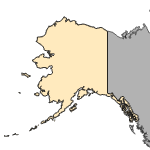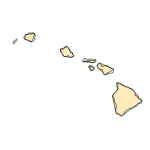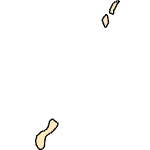Rivulus hartii
(Hart's rivulus)
Fishes
Exotic |
|
Common name: Hart's rivulus
Taxonomy: available through
www.itis.gov
Identification: Distinguishing characteristics and photographs were given by Huber (1992). The spelling for this species is sometimes given as Rivulus harti.
Size: 10 cm.
Native Range: Tropical America. Caribbean Slope drainages of Venezuela, South America, from Rio Aroa east to Rio San Juan; islands of Trinidad, Tobago, Grenada, and Margarita (J. E. Thomerson, personal communication).



|

Alaska |

Hawaii |

Puerto Rico &
Virgin Islands |

Guam Saipan |
Hydrologic Unit Codes (HUCs) Explained
Interactive maps: Point Distribution Maps
Nonindigenous Occurrences:
A population was discovered in a small ditch (flowing into the Salton Sea) draining a tropical fish farm in Imperial County, California (St. Amant 1970; Dill and Cordone 1997; Moyle 2002).
Table 1. States with nonindigenous occurrences, the earliest and latest observations in each state, and the tally and names of HUCs with observations†. Names and dates are hyperlinked to their relevant specimen records. The list of references for all nonindigenous occurrences of Rivulus hartii are found here.
Table last updated 12/19/2025
† Populations may not be currently present.
Ecology: Inhabits small pools, ponds, streams, and tributaries. Can access isolated waterbodies via terrestrial mobility over moist ground (Seghers 1978). Omnivorous: primarily feeds on insects and juvenile Poecilia reticulata. Can also jump up to 14 cm above water surface to reach prey on overhanging vegetation (Seghers 1978).
Means of Introduction: The California fish were first found in January 1967 (St. Amant 1970). This introduction was probably due to escape or release from a nearby fish farm.
Status: Locally established in California. The species was thought to have disappeared after 1969 (Shapavalov et al. 1981), but additional specimens were taken in 1990 (Courtenay et al. 1991; Swift et al. 1993). Moyle (2002) appears to indicate that it is still present, although he says it is probably not permanently established.
Impact of Introduction: The impacts of this species are currently unknown, as no studies have been done to determine how it has affected ecosystems in the invaded range. The absence of data does not equate to lack of effects. It does, however, mean that research is required to evaluate effects before conclusions can be made.
References: (click for full references)
Courtenay, W.R., Jr., D.P. Jennings, and J.D. Williams. 1991. Appendix 2: exotic fishes. 97-107
in Robins, C.R., R.M. Bailey, C.E. Bond, J.R. Brooker, E.A. Lachner, R.N. Lea, and W.B. Scott. Common and scientific names of fishes from the United States and Canada, 5th edition. American Fisheries Society Special Publication 20. American Fisheries Society, Bethesda, MD.
Dill, W.A., and A.J. Cordone. 1997. History and status of introduced fishes in California, 1871-1996. California Department of Fish and Game Fish Bulletin, volume 178.
Huber, J.H. 1992. Review of Rivulus -- ecobiogeography, relationships. Cybium, Société Française d'Ichtyologie, Paris, France.
Moyle, P. B. 2002. Inland fishes of California. Second edition. University of California Press, Berkeley, CA.
Seghers, B.H. 1978. Feeding behavior and terrestrial locomotion in the cyprinodontid fish, Rivulus hartii (Boulenger). Internationale Vereinigung fur Theoretische und Angerwandte Limnologie 20:2055-2059.
Shapovalov, L., A.J. Cordone, and W.A. Dill. 1981. A list of freshwater and anadromous fishes of California. California Fish ad Game 67(1):4-38.
St. Amant, J.A. 1970. Addition of Hart's rivulus, Rivulus hartii (Boulenger) to the California fauna. California Fish and Game 56(2):138.
Swift, C.C., T.R. Haglund, M. Ruiz, and R.N. Fisher. 1993. The status and distribution of the freshwater fishes of southern California. Bulletin of the Southern California Academy of Science 92(3):101-167.
Other Resources:
FishBase Summary
Author:
Leo Nico, Pam Fuller, and Matt Neilson
Revision Date: 4/30/2018
Peer Review Date: 6/28/2011
Citation Information:
Leo Nico, Pam Fuller, and Matt Neilson, 2025, Rivulus hartii (Boulenger, 1890): U.S. Geological Survey, Nonindigenous Aquatic Species Database, Gainesville, FL, https://nas.er.usgs.gov/queries/FactSheet.aspx?speciesID=881, Revision Date: 4/30/2018, Peer Review Date: 6/28/2011, Access Date: 12/19/2025
This information is preliminary or provisional and is subject to revision. It is being provided to meet the need for timely best science. The information has not received final approval by the U.S. Geological Survey (USGS) and is provided on the condition that neither the USGS nor the U.S. Government shall be held liable for any damages resulting from the authorized or unauthorized use of the information.